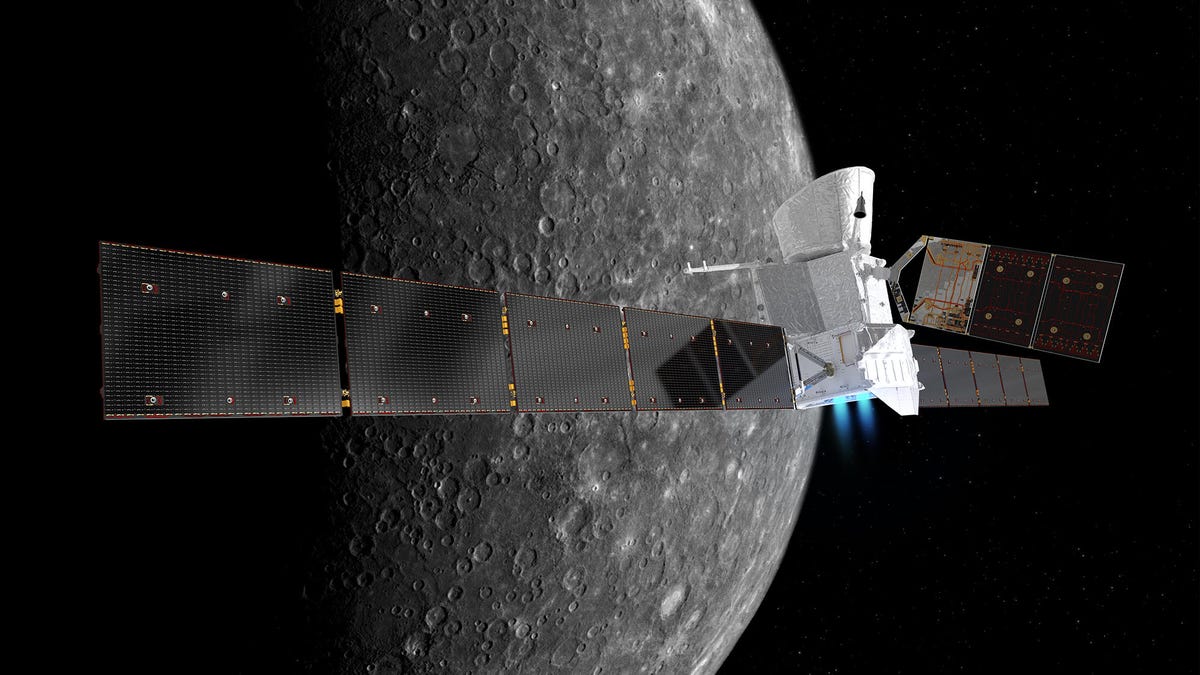Watch two spacecraft launch to one of the most mysterious planets
Space agencies from Europe and Japan are teaming up for the BepiColombo mission that'll send two orbiters to Mercury, one of the solar system's least explored worlds.

An international mission with a funny name is set to blast off from South America on Friday night, bound for a little-explored spot in the inner solar system.
BepiColombo is a seven-year, dual spacecraft mission to Mercury, the nearest planet to the sun, led by the European Space Agency (ESA) and the Japanese Aerospace Exploration Agency (JAXA).
The name is in honor of the Italian mathematician and engineer Giuseppe "Bepi" Colombo, who first explained Mercury's peculiar rotation pattern. (It spins on its axis three times for every two orbits around the sun). The mission consists of two orbiters, ESA's Mercury Planetary Orbiter and JAXA's Mercury Magnetospheric Orbiter, which will be launched and travel together via the ESA-built Mercury Transfer Module, which is a sort of cosmic semitrailer powered by solar electric propulsion.
The pair of orbiters will make a number of fly-bys of Earth, Venus and Mercury until December of 2025 when they'll enter orbit around the small planet and finally separate to study and map it in greater detail than ever before. In the process, scientists hope to understand more about how the planet formed and evolved so close to the sun, which may unlock insights about other stars and planets.
"(Mercury is) the planet that helped us prove that relativity is real, the planet that is astonishingly hot on its sun-side and yet carries ice in craters at its North Pole," Bill Nye, CEO of the Planetary Society, said in a statement. The spacecraft "will let us learn more about how the Solar System began, where we all came from, and how, on our own planet, you and I came to be."
A look at the BepiColombo mission schedule.
The Mercury Planetary Orbiter will take a close look at Mercury's surface and composition while the Mercury Magnetospheric Orbiter will analyze its magnetosphere. The mission also hopes to study the solar wind, Mercury's inner structure, and how Mercury interacts with the area around the sun.
"We really need to understand Mercury better," said David Rothery, professor of planetary geosciences at the UK Open University. "So much about it seems wrong for a planet that close to the Sun, so maybe it originated further out. A collision with the proto-Earth or proto-Venus could be what robbed it of so much of its original rock."
Mercury is a highly dense planet, and some scientists have speculated that it may have started with more of a rocky outer layer that was stripped away over time. Some other mysterious features of the planet that BepiColombo could help us better understand include why it appears to have shrunk over time and how it generates its own magnetic field despite spinning very slowly on its axis.
BepiColombo will be just the third mission to visit Mercury. NASA's Mariner 10 made three brief fly-bys in the 1970s, and the US space agency's Messenger orbiter circled the planet between March 2011 and April 2015, when it ran out of fuel and crashed onto Mercury's surface.
NASA's Messenger spacecraft mapped the north polar topography of Mercury. BepiColombo will take an even closer follow-up look with a range of instruments.
The new spacecraft will be carrying a different suite of instruments that should allow BepiColombo to confirm and build on the data collected by Messenger.
"This wider array of instruments will enable us to not only make new discoveries, but also review Messenger's data," said Dominique Delcourt, a member of the team running instruments on the Mercury Magnetospheric Orbiter. "By combining observations from both orbiters, we will also be in a position to perform what you might call stereoscopic measurements, something that was previously impossible."
Flying a mission so close to the sun is tricky for a few reasons. Obviously, it's going to be very hot, so BepiColombo is loaded with state-of-the-art high-temperature coatings, insulation, a radiator for the Mercury Planetary Orbiter, a special spinning technique for the Mercury Magnetospheric Orbiter and a sunshield for the cruise phase when it can't spin, all to avoid overheating.
But there will also be the sun's enormous gravity to deal with, and ion thrusters will be used to constantly push back against the pull of our star.
BepiColombo's long journey begins from the European spaceport at Kourou, French Guiana, where liftoff on an Ariane 5 rocket is scheduled for 6:45 p.m. Pacific Time on Friday (10:45 p.m. local time).
Watch live coverage of the launch below, starting at 6:15 p.m. PT:
NASA turns 60: The space agency has taken humanity farther than anyone else, and it has plans to go even farther.
Crowd Control: A crowdsourced science fiction novel written by CNET readers.

